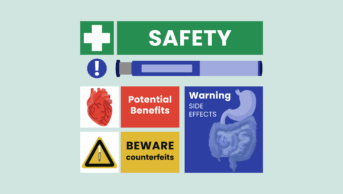We are entering a new phase of the NHS’s evolution as we embark upon the ten-year health plan, which is aimed at transforming where and how care is delivered1. As these changes are implemented, they will reveal new medication safety challenges and risks that will need to be managed.
As we stand, 330,000 medicines-related patient safety events were reported over the past 12 months to the ‘Learn from patient safety events’ service, a national NHS system for the recording and analysis of patient safety events that occur in healthcare2. It has been estimated that 1 in every 15 admissions to acute trusts is associated with an avoidable adverse drug reaction (ADR) and that the average length of stay for these admissions is six days, costing £0.9bn/year across England3.
The expectations of the public in relation to medication safety were described by Henrietta Hughes, patient safety commissioner for England, in her introduction to the ‘PSC Impact’ report, which was published in September 20254. “Patients deserve a healthcare system where safety is a top priority, where lessons are learned, and avoidable harms are removed,” she said4.
Harms associated with medicines are inequitably distributed across our population groups. Age, multimorbidity and ability to eliminate drugs are commonly described factors, but social and demographic factors — including deprivation and communication barriers — also expose the most vulnerable to greatest harm5.
It is important to understand the ergonomics of safety
Medication errors cost lives, reduce productivity and cause distress for patients and staff, all of which erodes the trust people have in the NHS6–8.
There is so much to do that it is hard to decide what to do first and how much resource to put towards it, particularly for a health service in a challenging financial position. The relationship between effort and reward is complicated and needs to be considered to prevent worse outcomes for as many people as possible.
Doing many of the things that we have always done is good. We have a strong reporting culture, both of safety events and Yellow Card ADRs. The systems and processes we have in place to conserve medication safety are effective. They are well embedded and are reflected by the enduring standards of patient safety9.
However, we also need to move with the times, fully adopting the Patient Safety Incident Response Framework10 to drive forward continuous improvement, managing the risks of new models of care, embracing what technology can deliver and making sure efforts to improve medication safety offers the best possible value for money.
Targeting high-value improvements
NHS staff are highly skilled, versatile and knowledgeable. These attributes ensure errors are avoided, night and day — every day. It is their efforts that make the difference to the patients they treat11. But improving medication safety is complex. It’s part of a socio-technical system with multiple transition points and staff need leadership to set them up to be the safest they possibly can be. Systems-thinking is an essential component of this leadership. It is also important to understand the ergonomics of safety and how organisations work together to deliver improvements for the population they serve.
No single individual, team or organisation can solve all the problems of medication safety on their own. Collaboration, shared learning and collective endeavours are needed. Leadership is recognised in the Dash Review as being essential to the delivery of high-quality care and leadership in medication safety exemplifies this opportunity12.
When it comes to medicines, it is pharmacy professionals that everyone turns to for guidance and leadership
Targeting the medicines and patients with the highest risks can deliver over 200% return on investment for the NHS — preventing significant harm, saving lives and releasing valuable clinical and financial resources. This focused approach addresses medicines with the lowest ‘number needed to harm’ and patients most vulnerable owing to physiological risk factors or health inequalities13.
Using this approach, leaders in medication safety can drive high value improvement so that every £100,000 spent:
- Saves more than 40 lives;
- Releases at least 750 bed days and more than 400 primary care appointments; and
- Releases over £0.3m in NHS resources.
Since 2014, the NHS has had a network of medication safety officers with cross-disciplinary expertise. This provides a strong foundation to grow the leadership needed across all NHS providers, extending into neighbourhood health providers as they develop.
Tight finances always mean tough choices. The best we can do is help as many people as possible with the resources available while addressing health inequalities. Having leaders in medicines safety who are trained in systems-thinking and who are part of effective learning networks can maintain essential standers of safety while building the infrastructure and culture for the new ways of working described in the ten-year health plan.
Building leadership and networks
Leadership is what makes safety easy for people, but it cannot be dominated by ‘command and control’. Effective leadership empowers front line staff to make change for the better. Safety leadership and quality improvement methodology are inextricably linked14.
Medicines safety is a team effort that crosses professional, managerial and organisational boundaries, but when it comes to medicines, it is pharmacy professionals that everyone turns to for guidance and leadership. Pharmacy professionals must respond to this, advocate for safety wherever possible and create opportunities to lead medication safety improvement.
Medication remains a top priority for patient safety in the NHS and the world over15,16. As we deliver the aspirations of the ten-year health plan and shift from sickness to prevention, analogue to digital and hospital to community, the NHS will need effective leadership to deliver high-value medicines safety improvements.
Well-networked medication safety officers are ideally placed to lead this work. The case for investing in medication safety leadership is stronger than ever in this time of change.
- 1.Fit for the future: 10 Year Health Plan for England. Department of Health and Social Care. July 2025. Accessed October 2025. https://www.gov.uk/government/publications/10-year-health-plan-for-england-fit-for-the-future
- 2.PSIMS Recorded Data Dashboard . NHS England. Accessed October 2025. https://www.england.nhs.uk/statistics/statistical-work-areas/patient-safety-data/#data
- 3.Osanlou R, Walker L, Hughes DA, Burnside G, Pirmohamed M. Adverse drug reactions, multimorbidity and polypharmacy: a prospective analysis of 1 month of medical admissions. BMJ Open. 2022;12(7):e055551. doi:10.1136/bmjopen-2021-055551
- 4.PSC Impact: The first three years of the Patient Safety Commissioner role. Patient Safety Commissioner. September 2025. Accessed October 2025. https://www.patientsafetycommissioner.org.uk/our-reports/psc-impact/
- 5.Wade C, Malhotra AM, McGuire P, Vincent C, Fowler A. Action on patient safety can reduce health inequalities. BMJ. Published online March 29, 2022:e067090. doi:10.1136/bmj-2021-067090
- 6.The financial and human cost of medical error: Executive summary . Betsy Lehman Center for Patient Safety. June 2019. Accessed October 2025. https://betsylehmancenterma.gov/assets/uploads/general/Cost-of-Medical-Error-Executive-Summary.pdf
- 7.Second Victim Support . Bradford Teaching Hospitals NHS Foundation Trust. Accessed October 2025. https://secondvictim.co.uk/
- 8.What causes a lack of trust in health and social care? Care Learning. December 2024. Accessed October 2025. https://carelearning.org.uk/blog/feedback-and-improvement/what-causes-a-lack-of-trust-in-health-and-social-care/
- 9.Enduring standards and general principles from previously issued patient safety alerts. NHS England. Accessed October 2025. https://www.england.nhs.uk/patient-safety/patient-safety-insight/patient-safety-alerts/enduring-standards/
- 10.Patient Safety Incident Response Framework (PSIRF) . NHS England. Accessed October 2025. https://www.england.nhs.uk/patient-safety/patient-safety-insight/incident-response-framework/
- 11.Hollnagel E, Wears R, Braithwaite J. From Safety-I to Safety-II: A White Paper . NHS England. 2015. Accessed October 2025. https://www.england.nhs.uk/signuptosafety/wp-content/uploads/sites/16/2015/10/safety-1-safety-2-whte-papr.pdf
- 12.Review of patient safety across the health and care landscape. Department of Health and Social Care. July 2025. Accessed October 2025. https://www.gov.uk/government/publications/review-of-patient-safety-across-the-health-and-care-landscape
- 13.The Case For Leadership in Medication Safety . FutureNHS Collaboration Platform. Accessed October 2025. https://future.nhs.uk/medicinessafetyimprovement/view?objectId=246070693
- 14.Innes J, Jamieson T, Dales R, Lloyd R. National quality improvement intervention to reduce high risk oral methotrexate prescribing. BMJ Open Qual. 2022;11(3):e001942. doi:10.1136/bmjoq-2022-001942
- 15.The NHS Patient Safety Strategy: Safer culture, safer systems, safer patients. NHS England and NHS Improvement. July 2019. Accessed October 2025. https://www.england.nhs.uk/wp-content/uploads/2020/08/190708_Patient_Safety_Strategy_for_website_v4.pdf
- 16.Global Patient Safety Action Plan 2021–2030: Towards eliminating avoidable harm in health care . World Health Organization. 2021. Accessed October 2025. https://www.who.int/teams/integrated-health-services/patient-safety/policy/global-patient-safety-action-plan



